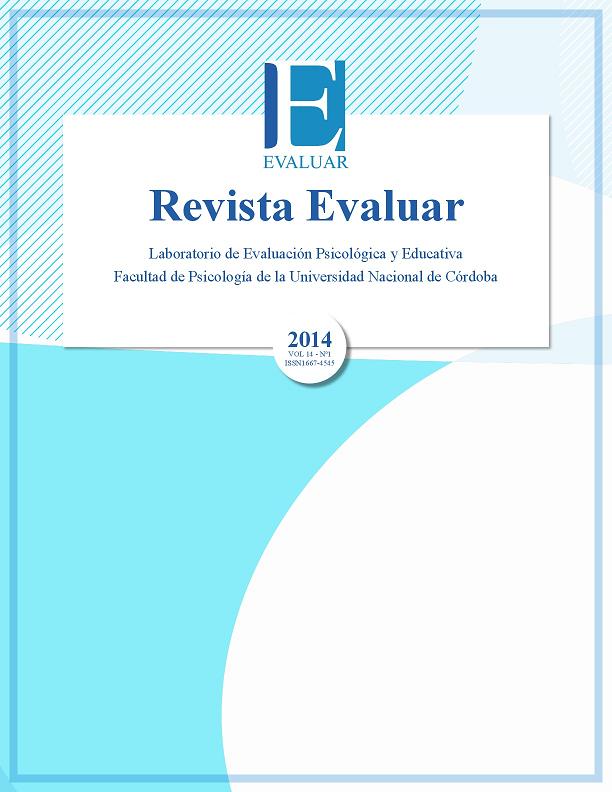Estimación por intervalo del tamaño del efecto expresado como proporción de varianza explicada
DOI:
https://doi.org/10.35670/1667-4545.v14.n1.11521Keywords:
tamaño del efecto, intervalos de confianza, software estadísticoAbstract
In recent yearsthere has been an increasing use of effect size measures to report results.The current article addresses various issues: first, the importance of compare results in communicating social research is discussed. Second, examples of applications of different measures of effect size are provided.Third, reason supporting that the estimation of effect size isnot simply extension of usual confidence intervals are illustrated. Lastly, MBSESSR language by INFOSTAT® for simply estimate.
Downloads
References
AERA [American Educational Research Association] (2006). Standards on reporting on empirical social science research in AERA publications. Educational Researcher, 35, 33–40.
Algina, J., Keselman, H. J., & Penfield, R. D. (2006). Confidence interval coverage for Cohen’seffect size statistic. Educational and Psychological Measurement, 66, 945-960.
APA [American Psychological Association]. (2010). Publication manual of the American Psychological Association(6ta ed.). Washington, DC.
Bayley, N. (1969). Manual for the Bayley scales of infant development. California, EE.UU.: The Psychological Corporation.
Cohen, J. (1962). “The statistical power of abnormal-social psychological research: A review” Journal of Abnormal and Social Psychology, 65(3), 145–153.
Cohen, J. (1988). Statistical power analysis for the behavioral sciences (2nd ed.). Hillsdale, NJ: Lawrence Earlbaum Associates.
Cohen, J. (1992). A power primer. Psychological Bulletin, 112 (1): 155–159.
Cohen, J. (1994). The earth is round (p < .05). American Psychologist, 49(12), 997–1003.
Cumming, G. & Finch, S. (2001). A primer on the understanding, use, and calculation of confidence intervals that are based on central and noncentral distributions. Educational and Psychological Measurement, 61, 633-649.
Di Rienzo J. A., Casanoves F., Balzarini M.G., Gonzalez L., Tablada M., Robledo C. W. (2012) InfoStat versión 2012. Grupo InfoStat, FCA, Universidad Nacional de Córdoba, Argentina. URL http://www.infostat.com.ar
Field, A. (2013). Effect sizes. Documento metodológico en Statistics Hell. Disponible en http://www.statisticshell.com/docs/effectsizes.pdfaccedida 3/7/2013
Frías Navarro, M., Llobell, J. & García Pérez, J. (2000). Tamaño del efecto del tratamiento y significación estadística. Psicothema, 12, Suplem.2, pp. 236-240
García García, J., Ortega Campos, E., De la Fuente Sánchez, L. (2011). The Use of the Effect Size in JCR Spanish Journals of Psychology: From Theory to Fact. The Spanish Journal of Psychology, 1050-1055.
Glass, G. (1976). Primary, secondary and meta-analysis of research. Educational Researcher, 10: 3-8.
Hedges, L. (1981). Distribution theory for Glass’s estimator of effect size and related estimators. Journal of Educational Statistics, 6(2), 106–128.
Howell, D. (2011). Confidence Intervals on Effect Size. Suplemento web de Statistical Methods for Psychology. Cengage Learning. Disponible en http://www.uvm.edu/~dhowell/methods8/Supplements/Confidence%20Intervals%20on%20Effect%20Size.pdfaccedida 3/7/2013
Kelley, K. & Lai, K. (2011). MBESS: MBESS. R package version 3.2.1.http://CRAN.R-project.org/package=MBESSaccedida 3/7/2013
Kelley, K. (2005). The effects of nonnormal distributions on confidence intervals around the standardized mean difference: Bootstrap and parametric confidence intervals. Educational and Psychological Measurement, 65, 51-69.
Kelley, K. (2007). Methods for the Behavioral, Educational, and Social Sciences: An R package Behavior Research Methods, 39 (4), 979-984
Kelley, K., & Rausch, J. R. (2006). Sample size planning for the standardized mean difference: Accuracy in parameter estimation via narrow confidence intervals. Psychological Methods, 11(4), 363–385.
Kirk, R. E. (2003). The importance of effect magnitude. En S.F. Davis (editor), Handbook of Research Methods in Experimental Psychology. Oxford, UK: Blackwell.
Lai, K. & Kelley, K. (2013). The MBESS Package. R wiki. Disponible en http://rwiki.sciviews.org/doku.php?id=packages:cran:mbessaccedida 3/7/2013
Meehl, P. (1978). Theoretical Risks and Tabular Asterisks: Sir Karl, Sir Ronald, and the Slow Progress of Soft Psychology, Journal of Consulting and Clinical Psychology Vol, 46, 806-834
Nickerson, R. S. (2000). Null hypothesis significance testing: A review of an old and continuing controversy, Psychological Methods, 5, 241-301.
Rodríguez, M., Calderón, L., Cabrera, L., Ibarra, N., Moya, P. y Faas, A. E. (2005). Análisis de Consistencia Interna de la Escala Bayley del Desarrollo Infantil para la Ciudad de Córdoba (Primer año de Vida). Evaluar, 5(1), 55–69. https://doi.org/10.35670/1667-4545.v5.n1.540
Smithson, M. (2001). Correct confidence intervals for various regression effect sizes and parameters: The importance of noncentral distributions in computing intervals. Educational and Psychological Measurement, 61, 605-632.
Smithson, M. J. (2003). Confidence Intervals. Quantitative Applications in the Social Sciences Series, No. 140. Thousand Oaks, CA: Sage.
Steiger, J. & Fouladi, R. (1997). Noncentral interval estimation and the evaluation of statistical models. En L. L. Harlow, S. A. Mulaik, & J. H. Steiger (Eds). What if there were no significance tests? Mahwah, N. J., Lawrence Erlbaum Associates.
Steiger, J. (2004). Beyond the F test: Effect size confidence intervals and tests of close fit in the analysis of variance and contrast analysis. Psychological Methods, 9, 164-182.
Sun,S., Pan, W., & Wang, L. (2010). A Comprehensive Review of Effect Size Reporting and Interpreting Practices in Academic Journals in Education and Psychology. Journal of Educational Psychology. Publicación on line. doi: 10.1037/a0019507
Wilkinson, L. & the Task Force on Statistical Inference (1999). Statistical Methods in Psychology Journals Guidelines and Explanations. American Psychologist American Psychological Association. Inc. Vol. 54, No. 8, 594-604
Wright, D. (2003). Making friends with your data: Improving how statistics are conducted and reported. British Journal of Educational Psychology, 73, 123–136. The British Psychological Society. University of Sussex, UK.
Downloads
Published
Issue
Section
License
Copyright (c) 2014 Eduardo Bologna

This work is licensed under a Creative Commons Attribution 4.0 International License.
Revista Evaluar aplica la Licencia Internacional de Atribuciones Comunes Creativas (Creative Commons Attribution License, CCAL). Bajo esta licencia, los autores retienen la propiedad de copyright de los artículos pero permiten que, sin que medie permiso de autor o editor, cualquier persona descargue y distribuya los artículos publicados en Evaluar. La única condición es que siempre y en todos los casos se cite a los autores y a la fuente original de publicación (i.e. Evaluar). El envío de artículos a Evaluar y la lectura de los mismos es totalmente gratuito.



